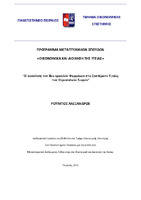Η διείσδυση των βιο-ομοειδών φαρμάκων στα συστήματα υγείας των ευρωπαϊκών χωρών
The penetration of biosimilar medicines into the health systems of European countries

View/
Keywords
Bιο-ομοειδή φάρμακα ; Βιολογικά φάρμακα ; Ανταλλαξιμότητα ; Αλλαγή θεραπείας ; Αδαλιμουμάμπη ; Πλαίσιο πολιτικής ; Πολιτική βιωσιμότητας ; Φαρμακευτική αγοράAbstract
It is a fact, that the biotechnology industry and more specifically the
biopharmaceutical industry has developed significantly in recent decades. Many
chronic and serious diseases such as cancer, diabetes, anemia, rheumatoid arthritis, and
multiple sclerosis that were considered incurable or even recognizable can now be
controlled and largely cured with the help of innovative treatments so-called biologics.
In addition, another very important achievement of biologics is the fact that they have
managed to improve the quality of life and treatment of patients who suffer from serious
and rare diseases.
Biological medicines are produced from molecular agents of living organisms (e.g.
proteins) and when their patent expires, another industry may produce a similar
biological molecule. These biological molecules are called biosimilars.
The aim of this study is to present in detail the development of biosimilar drugs, the
regulatory framework of their market, as well as the consequences of the entry of
biosimilar drugs into health systems in European countries. In addition, a main theme
that are analyzed in this paper is the planning of incentive offerings in EU countries.
(European Union), to achieve even greater and easier penetration of biosimilar drugs
into health systems in EU countries.
In writing this paper, I used the methodology of the bibliographic review by the
abduction method, utilizing recent and reliable scientific sources. For the purpose of
the thesis, various case studies were also studied, such as the case study of hospital sales
of Humira and its biosimilars in 8 European countries (France, Germany, Hungary,
Italy, Poland, Spain, Sweden, and the United Kingdom), with to examine whether
biosimilars have managed to penetrate European markets, and then to study some of
the reasons that contribute to the increased or respectively reduced uptake of bioidenticals. Finally, in conclusions is set out some proposals for the more efficient
integration of biosimilars and achieving market viability.


